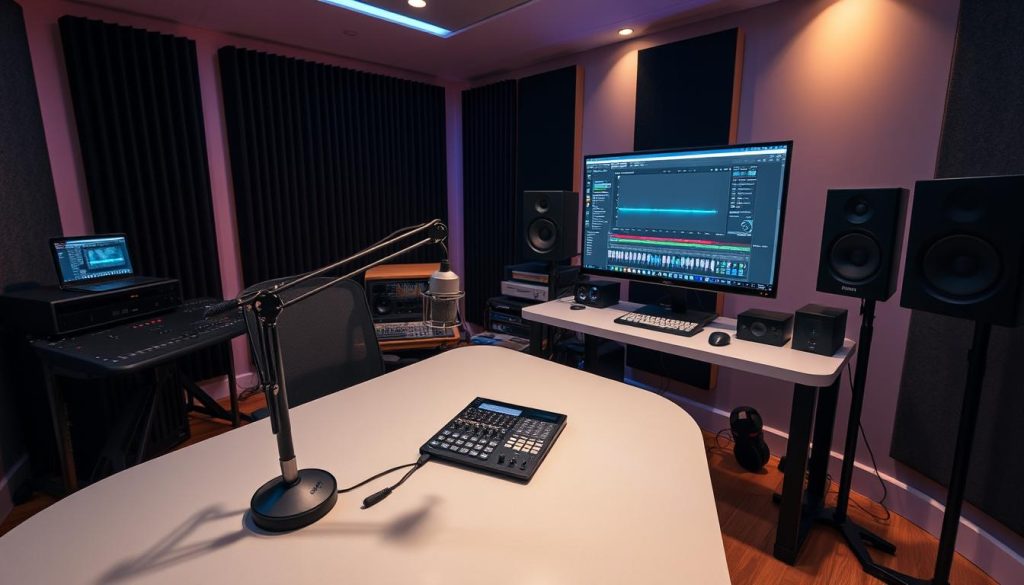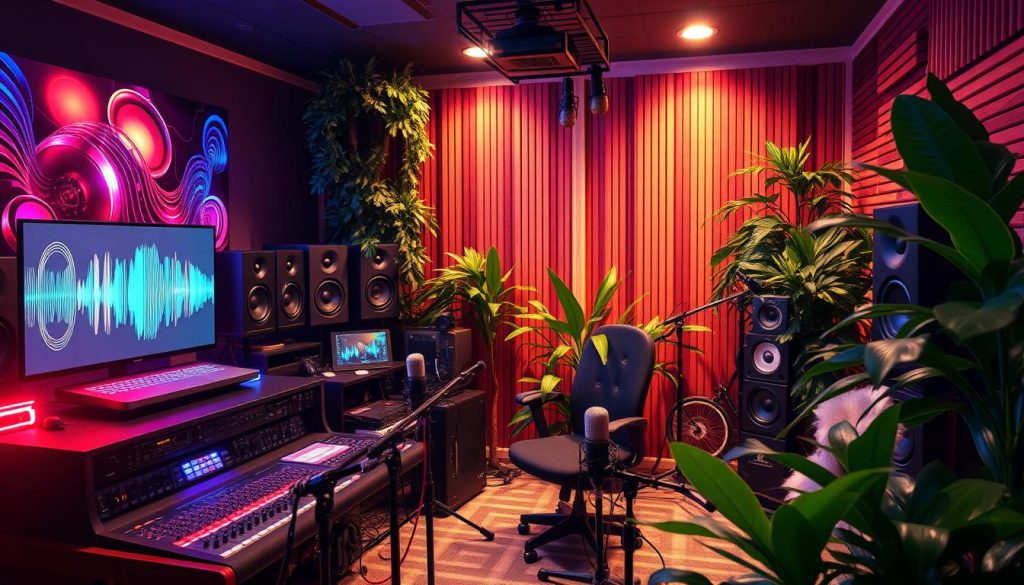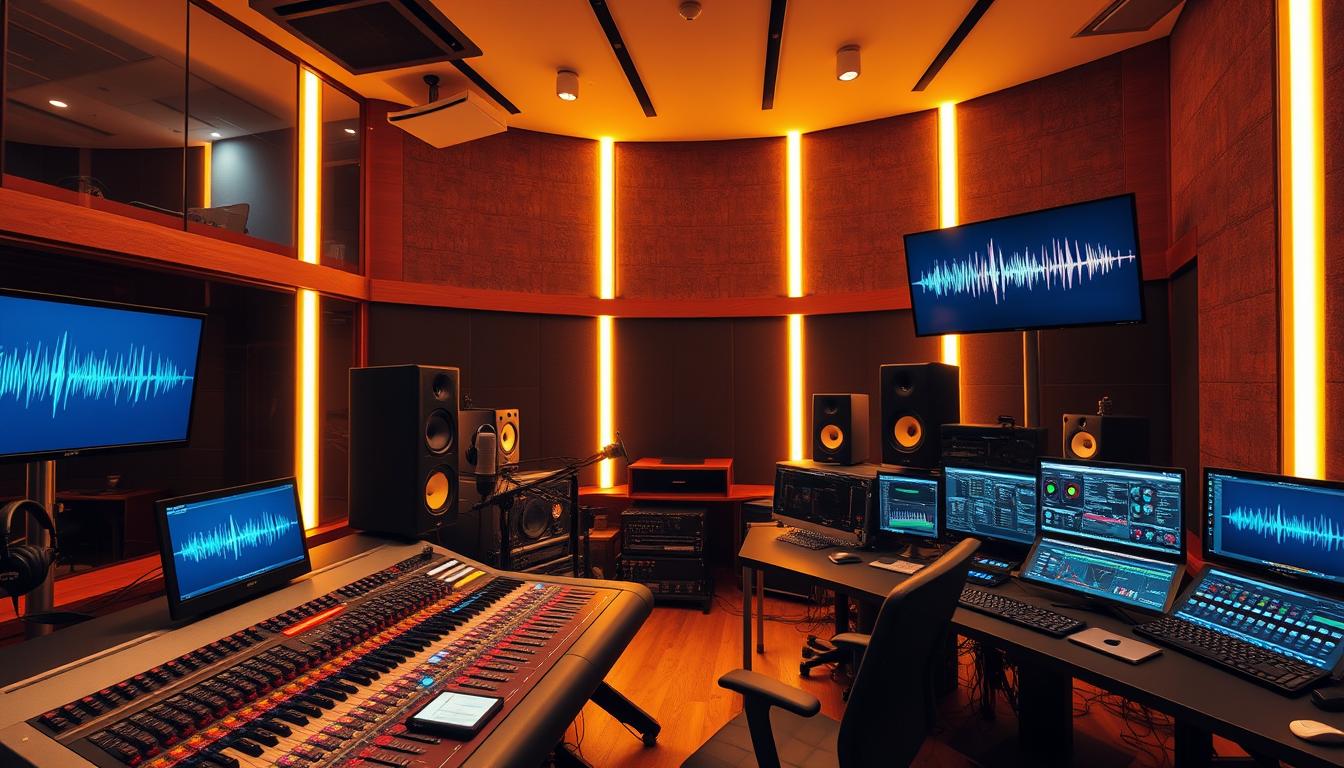In the world of podcasting, making great content is just the start. To really grab your listeners, you need to master post-production. This process can make your recordings sound amazing, showing off what your podcast is all about. This guide will cover the key steps and methods to boost your podcast’s audio quality.
Defining Your Podcast Post-Production Routine
Creating a good podcast post-production routine is key to making your show better. It starts before you record, by getting all your materials ready. This makes the post-production process smooth.
Laying the Groundwork for Smooth Post-Production
Important steps for a strong podcast pre-production routine are:
- Creating a detailed script or outline for the recording
- Collecting sound effects, music, and other audio bits
- Planning for guest interviews or special parts that need extra work
Preparing well in the podcast pre-production phase helps make recording preparation and audio organization easier. This makes the podcast planning and post-production smoother.
It’s also key to set the tone and style of your podcast early on. Deciding on editing techniques and sound effects keeps your podcast sounding consistent.
A solid pre-production routine makes post-production smooth. By planning and organizing well, you can make your podcast better and more impactful.
Step-by-Step Guide to Effective Podcast Post-Production

Making a podcast sound professional takes a lot of work after you record. This part is called post-production. It means editing your episode and making the audio sound great. Let’s look at the main steps to make your podcast sound better.
Step 1: Editing Your Episode
Start by putting your audio into editing software. Listen to the whole recording and cut out parts that aren’t needed. Get rid of background noise, pauses, and words like “um” and “uh.” Use crossfades to make the changes between parts smooth.
Step 2: Mixing for Optimal Sound
After editing, work on the mix. Make sure everything is at the same volume. This means making the voices, music, and sound effects work together well. By doing this, your podcast will sound amazing and keep your listeners interested.
Learning how to edit and mix podcasts is key to making your show sound great. By following these steps, you’ll make a podcast that people love to listen to.
| Podcast Editing Technique | Description |
|---|---|
| Trimming and Rearranging | Identifying and removing unwanted sections, such as background noise, pauses, and verbal fillers, to create a seamless flow. |
| Crossfades | Applying smooth transitions between segments to ensure a cohesive listening experience. |
| Level Adjustments | Balancing the volume of voices, music, and sound effects to achieve a professional audio mix. |
Crafting Engaging Sound Design

Making your podcast sound great is key to keeping your listeners hooked. Using podcast sound design, audio transitions, and background music can make your show stand out. This keeps your audience listening all the way through.
First, pick a musical theme that fits your podcast’s style. Background music can set the mood and tie different parts together. Choose songs or tunes that match the feelings you want to share.
- Use audio transitions to move smoothly between episode parts. Soft sound effects or short music pieces help signal changes in topic or mood. This keeps your podcast professional.
- Add sound effects to highlight key moments or deepen your stories. The right sound effects keep your listeners interested and connected to your show.
| Element | Purpose | Examples |
|---|---|---|
| Background Music | Set the mood, create emotional connection, provide cohesion | Instrumental tracks, ambient soundscapes, songs that match your genre |
| Audio Transitions | Guide listeners between segments, signal shifts in topic or tone | Subtle sound effects, brief musical cues, smooth transitions |
| Sound Effects | Punctuate key moments, add depth and realism to storytelling | Footsteps, door creaks, sounds from the environment, clicks from technology |
By carefully adding these podcast sound design elements, you can make your audio engaging and polished. This will make your listeners want to tune in again and again.
audio post-production
Audio post-production is key in making audio sound great. It happens after recording and mixing. It makes films, TV shows, music, and podcasts sound better.
Crafting the Sonic Atmosphere
Experts in audio post-production work on sound design. They add sound effects and Foley. They also mix dialogue and use ADR for better sound.
The Art of Audio Editing and Mixing
Audio editing and mixing are big parts of post-production. Engineers work hard to make the audio clean and clear. They fix levels and remove noise for a top-quality sound.
Elevating the Sound Design
Sound design is very important in post-production. It makes the sound match the visuals. The team creates realistic sounds and atmospheres. This brings stories to life and makes the experience better.
By focusing on editing, mixing, and sound design, experts make the final audio amazing. This draws in listeners and makes the production stand out.
Tips for Optimizing Your Post-Production Workflow
As a podcast creator, making your post-production workflow better is key. It helps you use your time well and work more efficiently. By finding and cutting out things that slow you down, you can make your work simpler and faster. This lets you do more in less time.
Prioritize Audio Quality
One key thing to do is focus on audio quality. Using top-notch microphones and gear is a must for getting great audio. This makes editing and mixing easier and more effective.
- Choose a professional-grade microphone that can capture clear, detailed audio without unwanted noise or distortion.
- Make sure your recording space is set up right to cut down on echo, reverb, and other issues that hurt audio quality.
- Keep your audio gear clean and in good shape to keep it working well.
By focusing on quality audio from the start, you’ll save time and effort later. This helps you make a podcast that sounds professional and top-notch for your listeners.
Remember, the right audio gear and a streamlined workflow can really change your podcast’s quality and success. Take the time to make your processes better and aim for the best audio quality. This will help your podcast stand out.
Mastering for a Polished Result
Mastering is the last step in making your podcast sound great. It makes your audio sound professional and polished. This process uses audio compression to make your mix sound better together.
It also adds loudness and uses limiting to stop your audio from getting too loud. This keeps the sound consistent on different devices.
Think about using stereo widening to make your podcast sound wider. This makes the audio seem deeper and more immersive. With these techniques, you can make your podcast sound clear and impactful.
The main goal of mastering is to make your podcast sound its best. It ensures your listeners have a great experience. By mastering your podcast, you’ll make a strong impression on your audience.
Key Mastering Techniques for Podcasters
- Apply gentle compression to “glue” the mix together and add overall loudness
- Use limiting to prevent clipping and maintain consistent levels across platforms
- Consider stereo widening techniques to enhance the perceived depth and width of your audio
- Aim for a well-balanced, clear, and impactful final mix
| Mastering Technique | Benefits |
|---|---|
| Compression | Glues the mix together, adds overall loudness |
| Limiting | Prevents clipping, ensures consistent levels across platforms |
| Stereo Widening | Enhances the perceived depth and width of the audio |
Software Tools and Techniques for Podcast Post-Production
Using the right software tools is key to making my podcast post-production smooth. Adobe Audition has a simple interface that makes editing easier. Logic Pro X offers advanced features for editing, mixing, and mastering audio.
Cloud-based platforms like Boomcaster and Riverside.FM are great for podcasters. They let me record audio and video and edit in real time. Hindenburg Journalist is another great tool, made for journalists and podcasters like me.
It’s important to keep up with the latest techniques and best practices. This helps me make my podcast sound professional. By using the best software and techniques, I can make my audio content better and connect with my listeners more.

